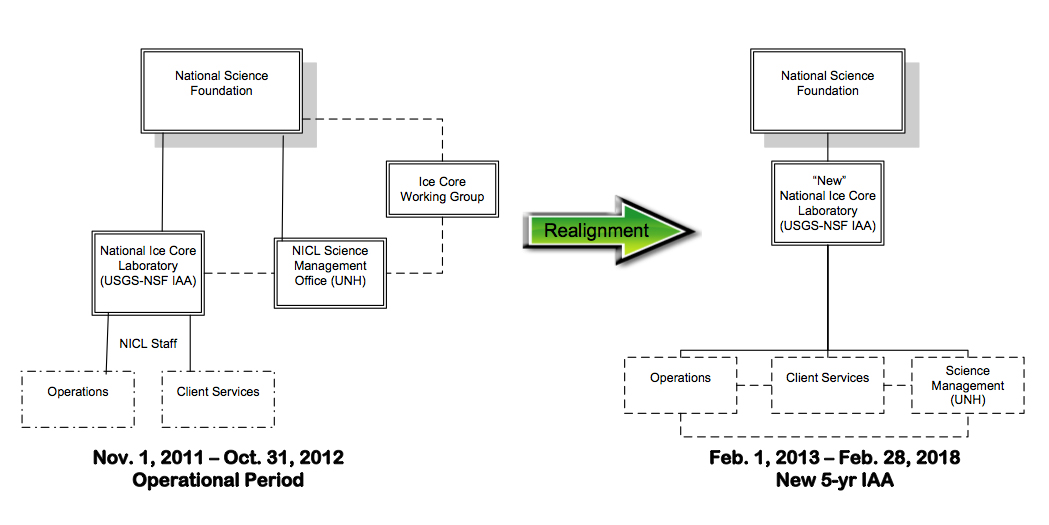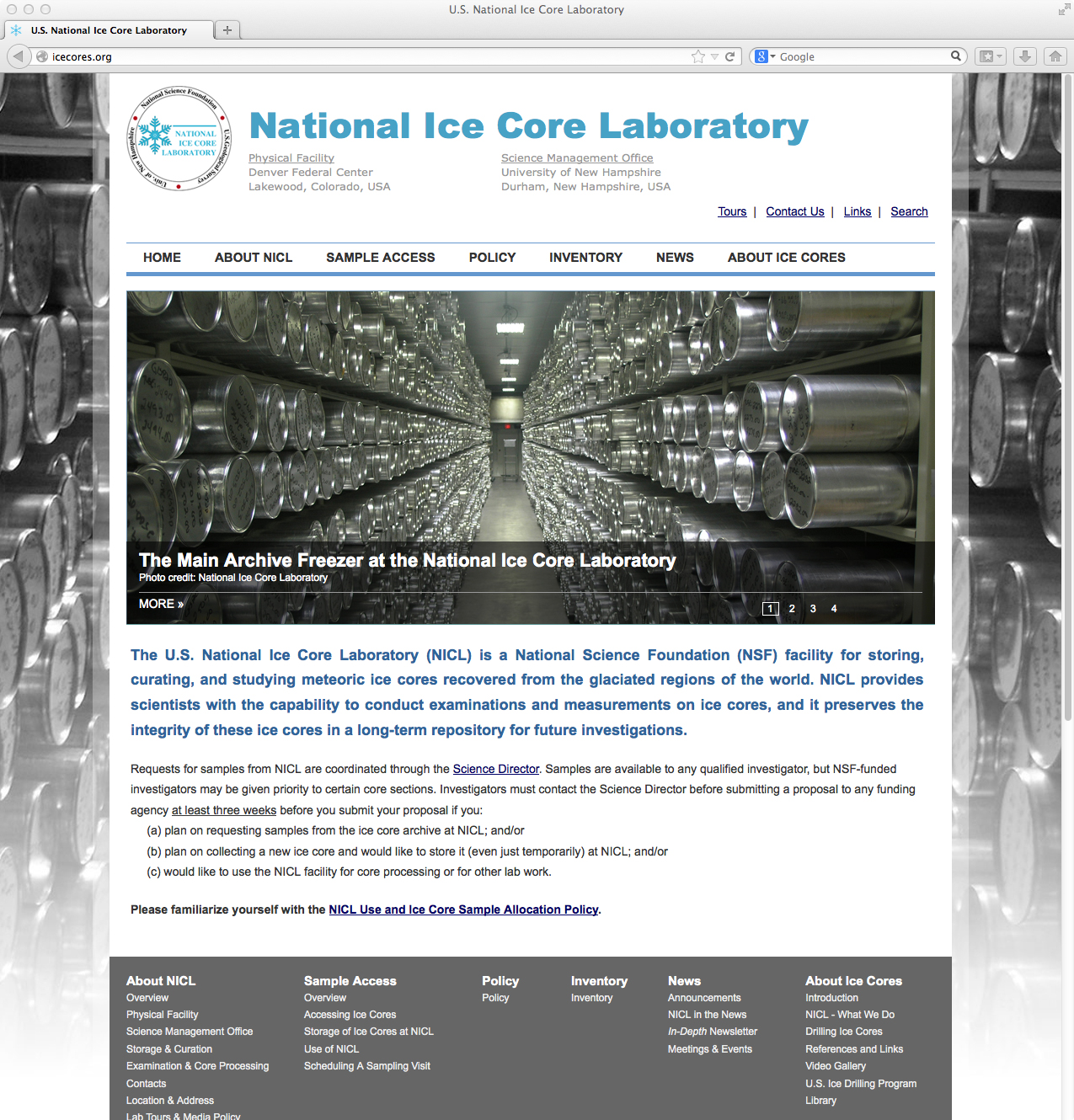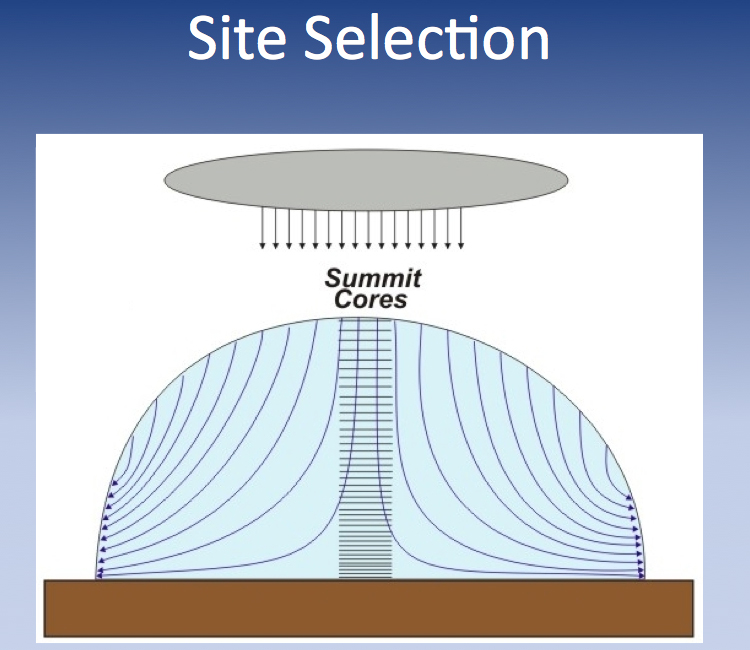On January 30, 2013 the National Science Foundation (NSF) and the United States Geological Survey (USGS) entered into a new Interagency Agreement (IAA) for "Operations and Maintenance of the National Ice Core Laboratory". The period of performance for this new IAA is February 1, 2013 and expires February 28, 2018.
This new 5-year IAA is for the continued 1) operations and maintenance of the NICL facility, 2) servicing of the ice core community with samples, and 3) day-to-day operations of the NICL-Science Management Office (NICL-SMO). This IAA integrates the NICL and NICL-SMO into one entity and brings all of the NICL-related functions into one funding umbrella (see Figure 1). Figure 1 shows how the organizational structure of the NICL and NICL-SMO changed from the previous IAA on the left into the current IAA on the right.


What has changed in the new NICL organizational structure?
The duties for the NICL staff remain the same. Those duties include performing operations such as the day-to-day operations and maintenance of the NICL facility, providing a safe and convenient lab space for processing ice cores, and performing client services such as ensuring cores are readily available to clients, ensuring the currency and availability of ice core inventory records, and assisting researchers in sampling events as much as possible.
A change from previous agreements between NSF and USGS is that the Science Management Office is now a part of the NICL agreement and no longer a separate agreement between NSF and the NICL-SMO. A subcontract for the science management of NICL was awarded to the University of New Hampshire (UNH). The Science Management Office (SMO) at UNH serves as the primary contact for scientists interested in access to ice cores; provides guidance to NSF and NICL staff on topics related to sample access, distribution, inventory, policy issues, operation and maintenance of the NICL, and future directions for ice core research; assists scientists and the public with matters related to ice core science; and hosts the new NICL/NICL-SMO website.
Prior to 2013, the NICL-SMO worked very closely with and coordinated the Ice Core Working Group (ICWG). In 2012 the ICWG was realigned as a working group to the Science Advisory Board of the Ice Drilling Program Office (https://icedrill.org). Although the ICWG is no longer coordinated by NICL-SMO, Mark Twickler (NICL-SMO Science Director) continues to rely on the ICWG for advice pertaining to the NICL facility.
So how will this affect the ice core community?
To the ice core community there will likely be little or no obvious change to how you carry out your research and interact with the NICL staff or NICL-SMO. Hopefully, your experiences will continue to be positive and we are able to improve our services to you. There are several exciting changes that make positive improvements to our facility and services.

Long Range Strategic Planning for NICL
The NICL facility uses R-22 Freon (HCFC-22). This refrigerant is currently being phased out. This phase-out schedule requires that the U.S. reduce its consumption of HCFCs by 90% below the U.S. baseline by January 1, 2015 and 99.5% below the baseline by January 1, 2020. R-22 can no longer be installed in new refrigeration systems; however, a refrigeration system such as the NICL facility which uses R-22 can continue to operate provided the R-22 has been recovered and recycled/reclaimed. Simply replacing R-22 in the NICL refrigeration system with a newer, environmentally friendly refrigerant is not feasible. The new refrigerants do not have the lubricity and other characteristics that are compatible with the existing equipment.
In addition, the storage capacity of the freezer is nearing its limit. The NICL main storage is now filled to about 95% of its capacity. Main storage has the ability to house an additional 3,500 tubes of 4-inch core.
NSF, NICL, NICL-SMO and the Ice Drilling Program Office are working together on developing a plan that will strategically address the following questions: How much ice core will be collected over the next 5, 10, 15, 20 years? What ice cores need to be kept? Which ones could be de-accessed? What will it take to retrofit the existing freezer? Should another smaller freezer box be built to assist during the retrofitting of the NICL freezer to a new refrigerant? What other improvements can be made to the facility? What is the best management structure for the long-term operation of the facility?
A report on the Long Range Strategic Planning for NICL will be submitted to NSF in 2014. If you would like to be a part of this report, please contact Mark Twickler via mark.twickler@unh.edu.
NICL and NICL-SMO Website
Prior to the new IAA the NICL and NICL-SMO had separate websites. With the integration of these two entities, the NICL-SMO combined both websites and UNH now hosts a new and much improved NICL website (https://icecores.org). One can now learn about the NICL and NICL-SMO through one portal. This new site is easy to navigate through and contains information about the NICL and NICL-SMO, how to access ice core samples, detailed information about NICL use and ice core sample allocation policy, access to the NICL inventory, information about NICL tours, and general information about ice cores. While the new website hosted by UNH is now active, the old NICL USGS website is still temporarily active. Eventually, only the NICL database will be hosted on the USGS website.
Outreach
The new 5-year IAA also includes plans to expand the NICL outreach effort. This has already begun. Brian Bencivengo, NICL Assistant Curator, worked extensively with the NICL staff and the University of Colorado, Denver, to develop a Microsoft PowerPoint presentation that is now being used for each NICL tour given. This presentation provides each tour with an exciting look into what goes on before ice gets to the NICL and then what happens when the ice does arrive here. This presentation goes over the background about ice core science discussing how scientists choose where to drill ice cores, how the ice forms, how the ice cores are drilled and retrieved, what field camps are like in Antarctica, what happens in the NICL freezer, and what the data collected from the ice cores tell us. We are looking into other venues in which to share the work that occurs at NICL with those individuals unable to visit us here at the NICL facility.
2013 and Beyond
The NICL and NICL-SMO have a lot of plans for the next five years. While we continue to service the ice core community's immediate needs, we are looking to the future to determine how we can best address many questions – even those that have not yet been asked. If you would like more information about the NICL or NICL-SMO, check out our website (https://icecores.org), and click "Contact Us" with any questions or comments. We look forward to hearing from you.
